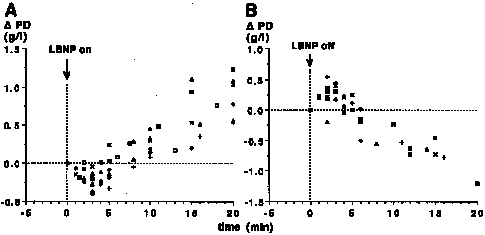
Hinghofer-Szalkay HG, König EM, Sauseng-Fellegger G, Zambo-Polz C
Biphasic blood volume changes with lower body suction in humans
Amer J Physiol. 1992; 263:H1270-5
![]()

Background & methods: We recorded blood and plasma mass density, and hematocrit of antecubital venous blood in 12 subjects in supine position before, during and after 20-40 min of lower body subatmospheric pressure (LBNP) of -35 mm Hg.
Results: Mass density values decreased during the first minutes of LBNP, indicating a transient 2.8% blood volume gain, before they rose as expected. After LBNP, a pronounced further density increase, indicating a further 1.5% hemoconcentration, preceded the return towards control. This pattern suggests reflex-driven transient filtration effects. Computed mass density of fluid exchanged between blood and extravascular space was 1007.2±4.4 g/l (37.0ºC); mass density of red cells remained unaltered.
Conclusion: We concluded that sudden unloading of central pressure receptors with LBNP causes microvascular fluid gain preceding fluid loss (hemoconcentration) during LBNP, and receptor loading after LBNP causes additionally fluid loss preceding inward filtration (hemodilution) during recovery. These effects can be quantified with high-precision blood and plasma mass densitometry performed by Mechanical Oscillator Technique (MOT).
Relative (to
time of change) plasma density at beginning (A) and termination (B) of LBNP. Different symbols
are different subjects (N=8)